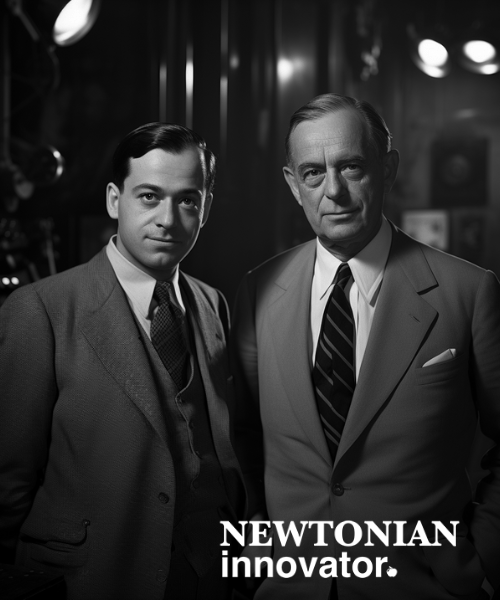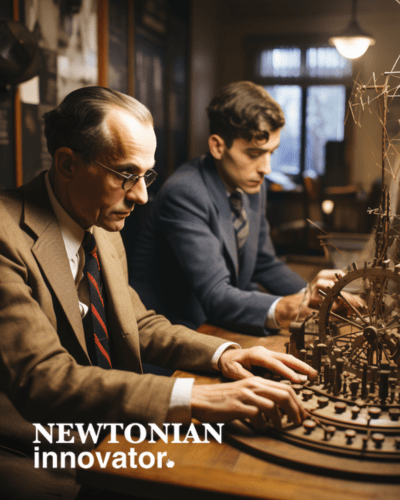Initially developed by mathematicians like John von Neumann and John Nash, game theory has applications in economics, biology, and political science. Game theory is a theoretical framework for analyzing strategic interactions between rational decision-makers. It was originally developed in economics to study competition and cooperation, but quickly expanded into other fields like political science, biology, and computer science. The basic components of a game theory model include the players, strategies, payoffs, and assumptions about rationality.
John von Neumann (1903-1957) was a Hungarian-American mathematician who contributed to numerous fields, including quantum mechanics, computer science, and economics. A child prodigy, he earned his PhD at 22 and joined the Hungarian Academy of Sciences at 25. He held positions at the Institute for Advanced Study in Princeton and other European universities. Instrumental in the Manhattan Project and the development of modern computers, von Neumann was also a pioneer in game theory. Alongside Oskar Morgenstern, he laid the foundations for this mathematical field with their book, “Theory of Games and Economic Behavior”. His minimax theorem provided equilibrium solutions for zero-sum games, influencing economics, warfare, and more.
John Forbes Nash Jr. (1928-2015) was an American mathematician renowned for his work in game theory, differential geometry, and partial differential equations. Awarded the 1994 Nobel Memorial Prize in Economic Sciences for his insights into non-cooperative games, Nash’s life and struggles with schizophrenia were depicted in the book and film “A Beautiful Mind”. He held academic positions at MIT and Princeton. Nash expanded game theory by introducing the Nash equilibrium, a solution for non-zero-sum games involving multiple players. His axiomatic Nash bargaining solution further advanced bargaining theory. Tragically, Nash and his wife passed away in a car accident in 2015.

Transitioning from the foundational work of von Neumann and Nash, one of the most illustrative and widely recognized concepts in game theory is the “Prisoner’s Dilemma.” This thought experiment encapsulates the tension between individual and collective rationality, showcasing how personal incentives can sometimes lead to subpar outcomes for all involved.
The Prisoner’s Dilemma is a classic conundrum. Imagine two suspects, A and B, arrested for a crime they jointly committed. Separated and unable to communicate, each faces a choice to cooperate with their partner by remaining silent or to betray them by testifying. The dilemma arises from the structure of the potential outcomes:
- If both remain silent (cooperate), they each serve a short sentence (e.g., 1 year).
- If both betray each other, they each serve a moderate sentence (e.g., 2 years).
- If one betrays and the other remains silent, the betrayer is released without any sentence, while the silent one serves a long sentence (e.g., 3 years).
From a purely self-interested perspective, each prisoner’s dominant strategy is to betray. No matter what the other does, a prisoner is better off betraying than remaining silent. However, when both follow this logic, they end up serving 2 years each, a worse outcome than if they had both remained silent and served only 1 year.
The Prisoner’s Dilemma encapsulates a fundamental tension in many real-world situations where individual incentives don’t align with collective well-being. From international politics to environmental conservation, variations of this dilemma recur, challenging decision-makers to find strategies that align individual and group interests.
The significance of the Prisoner’s Dilemma in game theory cannot be overstated. It highlights the complexities of strategic decision-making and the potential pitfalls of narrow self-interest. While the dilemma presents a pessimistic view of cooperation, it also offers a starting point for exploring mechanisms, such as repeated interactions or reputation considerations, that can inspire cooperation even in challenging scenarios.
Building on the foundational work of von Neumann and Nash, the Prisoner’s Dilemma has become a foundation in game theory, illustrating the intricacies of strategy, cooperation, and competition. It serves as a reminder that the best outcomes often require looking beyond immediate self-interest, emphasizing the importance of trust, communication, and long-term thinking. As we gain experience in an increasingly interconnected world, the lessons from this simple game theory model remain relevant, urging us to seek solutions that benefit not just ourselves, but collectively.
In the hall of scientific achievement, the mid-20th century stands out as a period of profound intellectual rise, particularly in the realm of mathematics and economics. Visionaries like John von Neumann, John Nash, and Oskar Morgenstern were at the forefront, pioneering the intricate field of game theory. Their objective? To dissect and understand the nuances of strategic decision-making through meticulously crafted theoretical models and thought experiments.
Central to their investigations were scenarios such as the Prisoner’s Dilemma, Stag Hunt, and the Nash Bargaining Problem. These hypothetical games, while seemingly abstract, unearthed deep-seated knowledge into the very nature of human behavior, cooperation, and competition. Concepts that emerged from these thought experiments, like the Nash equilibrium, backward induction, and minimax strategies, weren’t just theoretical curiosities. They evolved into foundational pillars that uphold modern game theory and its variety of applications.
From the corridors of political powerhouses to the intricacies of evolutionary biology, the principles derived from these game theory experiments have found resonance. These abstract puzzles have provided a lens through which we can better understand the complexities of human interactions and the strategic choices that people make everyday.
What makes these game theory experiments captivating is their ability to extract the multifaceted complexity of human contemplation and options. As von Neumann astutely observed, “All stable processes we shall predict. All unstable processes we shall control.” Through game theory, we are afforded a vantage point to predict, understand, and even influence the strategic roles that define human behavior. The undiminished relevance of these thought experiments, decades after their inception, speaks volumes about their timeless nature and their capacity to shed light on the specific patterns that govern our actions and choices.
In our rapidly evolving global landscape, the principles of game theory remain as relevant by offering individuals and institutions a strategic edge in navigating complex scenarios. For individuals, understanding game theory can enhance decision-making in everyday situations, from negotiating a salary to making informed choices in competitive environments. By recognizing the potential moves of others and anticipating their reactions to our decisions, we can optimize our outcomes in both personal and professional arenas.
But beyond these practical applications, the true potential of game theory lies in its ability to inspire the next generation of researchers. Just as von Neumann, Nash, and Morgenstern used abstract thought experiments to uncover fundamental truths about human behavior, today’s scholars can employ game theory to explore uncharted territories in various disciplines.
Imagine a biologist using game theoretic models to understand the cooperative behaviors of microorganisms in extreme environments, shedding light on the very origins of life. Or an astrophysicist employing game theory to predict the interactions of galaxies, turning the vast cosmos into a grand strategic game. The possibilities are endless.

For new researchers, the journey into game theory should begin with a deep appreciation for its foundational concepts, but it shouldn’t end there. By integrating game theoretic principles with insights from other disciplines, novel frameworks can emerge that capture the complexities of modern challenges. Whether it’s understanding the dynamics of social networks, predicting the spread of new technologies, or exploring the strategic behaviors of artificial intelligences, game theory offers a rich toolkit for inquiry.
Game theory isn’t just a relic of 20th-century thought. It’s a vibrant and evolving field with the power to transform our understanding of the world and perhaps beyond. By embracing its principles and pushing its boundaries, we can not only navigate the complexities of today’s world, but also lay the groundwork for groundbreaking discoveries in the future. To the researchers of tomorrow, may you find inspiration in the strategies of the past and chart new territories in the grand game of discovery.






